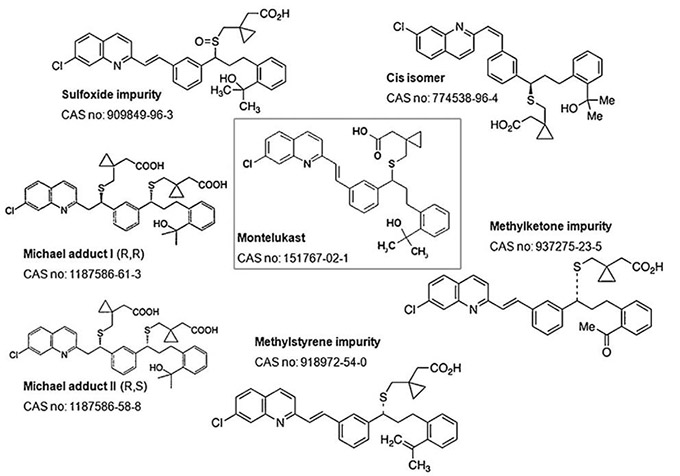Drug impurities, which may affect the quality, safety and effectiveness of drugs, have become one of the key concerns of drug regulators. With the expansion of pharmaceutical product scale, it has become a common topic for drug manufacturers to understand relevant laws and regulations on drug impurities control and strengthen the analysis and control of drug impurities. For different impurities, appropriate detection methods should be selected according to their physicochemical properties or biological activity, and the limit of residue should also be specified according to their influence on the safety and effectiveness of the drug. The detection and analysis of impurities is an important factor to guarantee the quality and safety of drugs.

Figure 1. Montelukast and its impurities
The impurities of protein biosimilars are the same as those of biological drugs, and their type and quantity will affect the safety of the final drug. The identification, quantification, characterization and the control of impurities are very important in the development process. According to the sources, impurities can be divided into two major categories of foreign pollutants and product-related impurities. Foreign pollutants include microbial contamination, pyrogen, cell composition, composition of culture medium, something from each step in the process and material from the purification steps, etc, while product-related impurities include mutation, error of pyrolysis products, disulfide isomer, dimers and polymer, and so on. For example, Montelukast is produced with a lot of impurities, as shown in the Figure1. Different analytical methods are needed to analyze different impurities. At present, the methods to study the impurities of protein drugs mainly include the chromatographic method, electrophoresis method, and immune method. Our company provides those services to detect impurities of protein biosimilars.
Process and Product-related Impurities at Creative Proteomics
- Host Cell Proteins (HCP)
The production of protein biosimilars needs to choose a suitable host cell, and host cells for expressing target product will inevitably be a synthesis of a variety of host cell proteins. These proteins will cause pollution to drugs, which may affect the activity of the drug, efficacy, and safety. To monitor the host cell proteins, currently the most widely used method is still the ELISA, which is simple to operate, highly sensitive, and convenient to establish control range and operation specification. SDS-PAGE, Dot blot and Western blot are also commonly used in HCP detection. Our company can provide enzyme-linked immuno sorbent assay (ELISA), sodium dodecyl sulfate polyacrylamide gel electrophores (SDS-PAGE), Dot blot and Western blot services.
- Protein Aggregates
During the production, preparation and storage of protein biosimilars, it is inevitable that some forced denaturing conditions, such as hyperacidity and thermal denaturation, are easy to produce protein entanglement and form polymers. Because the polysome has the same structure as the drug itself, the body's immune response to the drug polysome is often simultaneously immune to the drug, resulting in shortened half-life in the drug body. Therefore, the detection of polymer cannot be neglected. Our company can provide SDS-PAGE and size exclusion high performance liquid chromatography (SEC-HPLC) to help you detect polymer impurities.
- Truncated Forms
Protein breakage often occurs in the production, preparation and storage of protein biosimilars, resulting in shorter proteins. The truncation of some proteins may not only change their biological activity and in vivo pharmacokinetic characteristics, but also become a relatively strong antigenic substance of the body, which causes an immune response, and thereby affects the safety and effectiveness of the drug. The most common detection method is mass spectrometry that our company can provide.
- Post-translational Modifications (PTMs)
Precursors are inactive and often require a series of post-translational processing to become functional mature proteins. The types of processing are varied, such as removal of N-terminal fMet or Met, formation of disulfide bonds, chemical modifications and shearing, etc. Modification also includes phosphorylation, methylation, acetylation, glycosylation, and so on. The impurities derived from post-translational modifications can be analyzed by ion exchange chromatography, isoelectric focusing (IEF), peptide map, MS-MS and NMR. And our company is at the forefront of these technologies.
Our Advantages
- We can provide all kinds of impurity drug information for your protein biosimilar, so that you can have a more comprehensive understanding of your drug.
- We can provide various and validated methods and techniques for analyzing related impurities to make your detection process more efficient.
- The variety of impurities changes rapidly, so the methods and techniques for detecting impurities need constant improvement and innovation, while our company can provide you with the best service by tracking the latest methods and technologies in real time.
Based on our team's strong ability to search information and track new technologies and methods in real time, Creative Proteomics can provide more comprehensive impurity detection methods and technologies to help you detect impurities of protein biosimilars more efficiently, thus improving your economic efficiency. Our ordering procedure is as follows. If you have any questions or specific needs, don’t hesitate to contact us.
Reference
- Emerce E, etc. Determination of the impurities in drug products containing montelukast and in silico/in vitro genotoxicological assessments of sulfoxide impurity. Toxicology Letters, 2015, 238(2):90-99.






